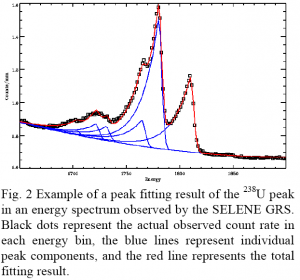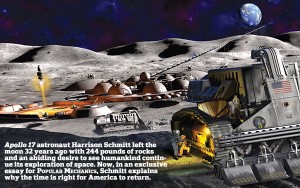Uranium on the moon. Mining the moon?
International Space Station – some news.
June 27, 2009Live talk today: Implications of the Law of Accelerating Returns for the Search for ETI
July 2, 2009Hello,
I will briefly report today that Uranium, a very famous radioactive element was found on the surface of the moon thanks to the gamma-ray spectrometer on board the Japanese mission called Kayuga.
I already described extensively the Kayuga mission,officially named SELENE (“Selenological and Engineering Explorer”), in my previous posts. The orbiter of this mission is equipped with a gamma-ray spectrometer which allows the identification of atoms which composed the surface of the moon. The principle is relatively simple: the surface of an airless body (moon, mars) is subjected to a continual bombardment of high-energy cosmic rays, which excite nuclei in it to emit characteristic gamma-rays which can be detected from orbit [adapted from wikipedia]. Analyzing the spectrum, the scientisits are able to determine the composition in elements and isotopes. It is definitely a powerful technique to determine the composition of a surface by remote sensing.
During the last LPSC conference near Houston, various group published preliminary studies of the Gamma Ray Spectrometer (GRS) data collected by Kayuga main orbiter for 2 years. The mission ended recently with a controled crash on the surface of the moon (see these 2 posts A and B). Yamashita and his colleagues reported in a brief paper the detection of Uranium, Thorium and Potassium. I am attaching below, and for the specialists, a part of the spectrum showing the emission peak corresponding to Uranium (which is in fact the addition of various emission lines) extracted from their article.
If you have a look on another paper, also presented at the LPSC conference, by Reedy and his colleague, you will see that the gamma ray spectrum (Fig.1) contains a large number of emission lines complicating significantly their identifications. Analyzing the intensity of these lines, planetary scientists are able to build map of distribution of materials on the surface of the moon.
So concretely, why this discovery is important and what will it change? Not much for the moment, it is only another step in our understanding of this close neighbor. However, if in the future we do need to produce energy for our lunar bases, it will be possible to envision the use of this uranium for this purpose creating something like nuclear-powered colony?
My goal today was to illustrate today how from the fit on a few dots in data collected by a spacecraft, we can get science fiction dreams again… 🙂
If you want to know more about mining the moon. you should check out the October 2004 issue of Popular mechanics. I am attaching a copy of the first artistic figure.

